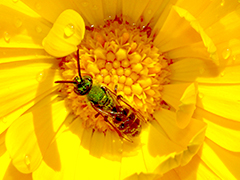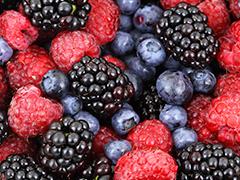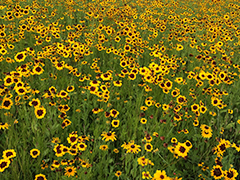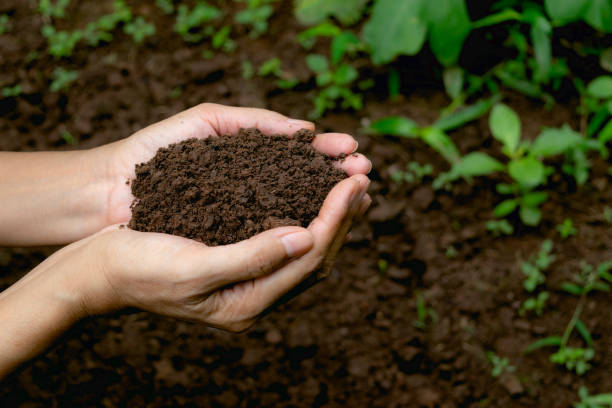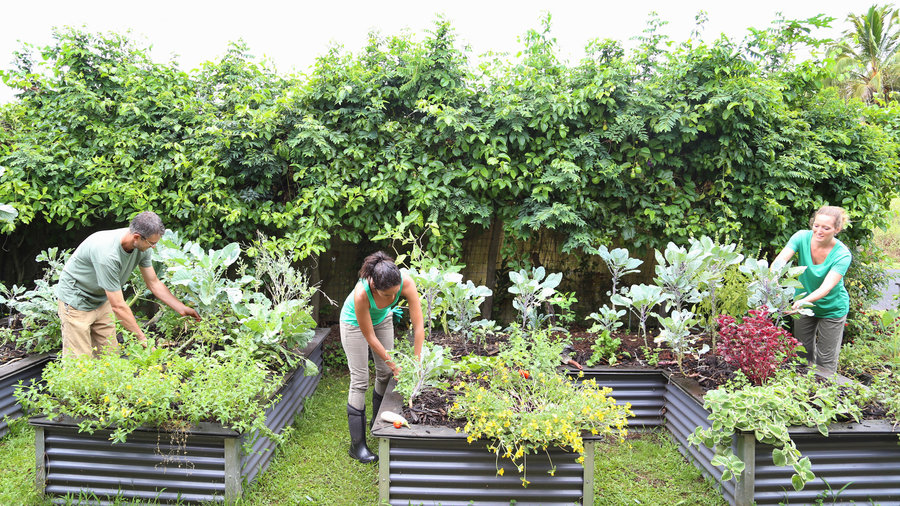Check out this transformation! Way back in 2010 we planted 33 street trees on SE Woodstock and SE Martins between SE 80th-82nd. We partnered with the wonderful organization 'Friends of Trees.'

'Our Happy Block' is a grassroots SE Portland Neighborhood Coalition formed to improve livability through volunteer projects and sustainable community design. We live and work in the vicinity of SE 80th-82nd Avenue and SE Woodstock Blvd/SE Martins Street in Portland, Oregon....where the heart-bomb mural is located.
Oct 29, 2025
Jul 22, 2025
Pollinator Plant Photos (July 2025)
Apr 28, 2025
Neighborhood Garden!
Neighborhood Garden Video (2024 bounty!)
Visit this page to get more info on our neighborhood garden ... sign up for a plot!
Oct 6, 2024
Planting Day: November 2nd, 2024
Let's Plant Some Pollinators!
Join Depave and Our Happy Block for a planting event on Saturday, November 2 from 10am - 1pm at the Horeb Oromo Church! Originally depaved in 2011, this 4,300 square foot Depave project site includes raingardens and a native planting strip as part of a parking lot retrofit project.
Help to add plants to the site and give the greenspace some love!
This planting is supported by the Xerces Society’s Habitat Kits program, thank you!
- where: Horeb Oromo Church (8040 SE Woodstock Blvd, Portland OR 97206)
- when: November 2nd, 2024 (Saturday) 10 am - 1pm
- Lunch provided by Horeb Oromo Church
| Click here to sign up! |
 |
| Volunteers after depaving in 2011 |
Xerces Programs
Jun 22, 2024
Save The Date: Block Party August 10th!

Hello Neighbors!
- paper plates
- cups
- utensils
- drinks
- games
- folding tables
contact us if you have items you'd like to bring and/or donate
Apr 24, 2024
Good Garden Day
On Saturday, April 20th we got some work done at the Neighborhood Food Garden!
- added compost to all the garden beds
- built another garden bed
- put pavers down beneath our new Jora Composter - it's now in service...composting our food scraps. We're making our own rich compost on site now. hooray!
 |
| Garden Volunteers on 4/20/24 |
Xerces program website
 |
| Dave about to hand-dig Arum (an invasive species) Cascade Naturescapes |
Apr 19, 2024
Earth Day Event! Volunteer!
Oh how beautiful it is!
☀ CELEBRATE EARTH DAY!Join us tomorrow (Saturday, 4/20) to add compost to our garden beds! Local Volunteer Nate is picking up compost and planning to drop it off around 10 am. Bring work gloves, a shovel and a wheelbarrow, if you have them.
Also, we have more cedar to build more garden beds - so if you're handy like that - we could use your skills!
Address: 8052 SE Martins Street, Portland OR 97206
If you aren't aware, the City of Portland is giving away free compost to celebrate earth day. Check it out!
Sep 14, 2023
Free Rain Garden, Naturescaping & Native Plant Workshop! October 14, 2023 (1:00-2:30pm)
Our Happy Block & Horeb Oromo organized a FREE Community Workshop with the wonderful organization East Multnomah Soil & Water Conservation District. (EMSWCD also partly funded our Neighborhood Garden! Thanks!)
- Facebook Event Invite
- when: October 14, 2023 (Saturday) from 1:00-2:30pm
- where: Horeb Oromo Church is hosting the event: 8040 SE Woodstock Blvd
- Please enter on the East side of the building (facing the parking lot) - who: You!
The workshop will focus on Rain Gardens, Naturescaping and Native Plants!
Rain Gardens: A rain garden is a sunken garden bed that captures storm water runoff from hard surfaces like rooftops, sidewalks and driveways, and allows it to soak back into the ground naturally. Rain Gardens help you use one of our most plentiful resources – rain!
Naturescaping: Naturescaping is the practice of using native plants and simple techniques that mimic nature so you can have a garden that helps you reduce your water use, your use of harmful chemicals and your maintenance.
Native Plants: Native plants provide a beautiful, hardy, drought-resistant, low-maintenance landscape while benefiting the environment. Native plants need less watering once established, and save time and money by eliminating or significantly reducing the need for fertilizers, pesticides, and lawn maintenance equipment.
Learn more at www.emswcd.org/in-your-yard
Sep 8, 2023
Neighborhood Food Garden Update
🌽 NEIGHBORHOOD FOOD GARDEN 🍓

We're making good progress at the neighborhood garden! We had a trial growing season this summer and learned some things. We have a lot to learn and improve, but we're excited for the bounty to come!
This fall and winter we will be planning for the 2024 growing season. We need to figure out garden rules (such as no pesticides, etc), how many plots we'll have to offer and what the plot fees will be. (Fees will be used to pay for water, improvements and repairs around the garden.)
Garden Plot!
If you're interested in a garden plot, please let me know!
Also, if you have an ideal plot size, that would be good to know as well for planning purposes. (for example: 4-foot x 4-foot or 8-foot x 4-foot...etc)
We are adopting the Square Foot Garden Method.
(If you don't reach out now, don't worry... I'll reach out again once we've figured some things out.)
Volunteer! (Go Vols!)
Please let me know if you want to be part of the volunteer group making all of this happen! (weeding, moving soil, build beds, make hoop houses, sow seeds...etc)
Garden Wish List (do you have any of this to donate?):
- Worms for Worm Bin Composting
- Worm Composting Bin
- Bird Bath
- Organic Compost
- Organic Fertilizer
- Organic veggie seeds
- Pollinator Plants
- Hoop House Materials
- Garden Tools
- Small Greenhouse
- Skills to help
Jun 15, 2023
Fill the Garden Beds with Soil on June 24th!
Join us for a volunteer work day...
we're filling the garden beds with soil!
- When: June 24th, 2023 at 1:00 pm (Saturday)
- Where: Horeb Oromo Church (8047 SE Martins Street) - between SE 80th and 82nd Ave
- Tools to bring (if you have them):
- wheelbarrow
- garden gloves
- shovel
If you'd like to bring snacks, food or drinks...great!
Here is a video of the garden beds thus far:
Mar 20, 2022
We are building a Neighborhood Food Garden on Our Happy Block! Get Involved!
DO YOU WANT A GARDEN PLOT?
DO YOU WANT TO VOLUNTEER TO HELP BUILD IT?
The new vegetable/fruit garden will face SE Martins Street between 80th & 82nd Avenue on Calvary Church’s land (at 8040 SE Woodstock Blvd ...Thanks Calvary for lending your land to the neighborhood!!!)

Project Summary:
We are creating this Neighborhood Garden to increase our community’s access to healthy, affordable food, while improving individual health and strengthening our neighborhood bonds. A community garden provides opportunities for inter-generational and cross-cultural connections. Our neighborhood is quite diverse and we’d like to celebrate that by having a space for all to come together. Our hope is that families from all cultures can have a space to grow their own food including international food that might not be available in the supermarket.
We love the idea that a garden, and a shared goal that benefits all, stimulates social interaction, which we have all lacked during the pandemic. Let's come together for something amazing!
Get a Plot - Volunteer!
Would you or your organization like to sponsor the garden? Please let us know! Thanks!
Our Partners for this Neighborhood Garden:
We would like to thank the following amazing organizations for the grant funds to make this neighborhood garden possible:
Past Partners
I also want to give a huge shout-out to the organizations and individuals that have helped us over the past decade to make our neighborhood a more livable, friendly place (for humans and the environment!) Read about the past partners here (Depave, BES, Friends of Trees, EMSWCD, SE Uplift, Prosper Portland, Neighborhood Volunteers)
Location
Pictures of Community Gardens
Jan 15, 2022
OHB Neighborhood (Food!) Garden is in the Planning Stage!
It's been a long time since I've updated this blog. I had a bit of volunteer fatigue...however I'm ready to get going on the long awaited neighborhood garden (to be located on the sunny South lawn of Calvary Church.)
Exciting news...we have secured a grant from EMSWCD in the amount of $2,000 to go toward the neighborhood garden! In addition to that, we have applied for another grant through SE Uplift and we plan to hear from them within the next month or so.
Project Summary:
We are creating this Neighborhood Garden to increase our community’s access to healthy, affordable food, while improving individual health and strengthening our neighborhood bonds. A community garden provides opportunities for inter-generational and cross-cultural connections. Our neighborhood is quite diverse and we’d like to celebrate that by having a space for all to come together. Our hope is that families from all cultures can have a space to grow traditional food that might not be available in the supermarket, and cross-pollinate with neighbors through food, gardening and all interests in between.
We love the idea that a garden, and a shared goal that benefits all, stimulates social interaction, which we have all lacked during the pandemic.
Goals & Anticipated Outcomes:
We anticipate the garden to attract community members that haven’t had access to an outdoor space to grow vegetables and fruits, folks that don't have a sunny space in their yard...and just anyone who wants to share the joy of gardening together.
The social organizational underpinnings of gardens give rise to a range of social processes, including social connections, reciprocity, mutual trust, collective decision-making, civic engagement and community building, all important processes associated with improving individual health and strengthening neighborhoods. Twiss et al., 2003; Armstrong, 2000; Cohen et al., 2006; Landman, 1993).
Benefits of Community Gardening (Information from American Community Garden Association)
- Improves the quality of life for people in the garden
- Provides a catalyst for neighborhood and community development
- Stimulates Social Interaction
- Encourages Self-Reliance
- Beautifies Neighborhoods
- Produces Nutritious Food
- Reduces Family Food Budgets
- Conserves Resources
- Creates opportunity for recreation, exercise, therapy, and education
- Reduces Crime
- Preserves Green Space
- Reduces city heat from streets and parking lots
- Provides opportunities for intergenerational and cross-cultural connections
- Remove 1,650 square feet of existing sod and dispose (rent sod-cutter)
- Level dirt
- Install local water meter on hose bib so that the church knows the amount of water being used solely for garden
- Install water/irrigation lines to plots
- Lay landscape fabric/burlap down to prevent weeds
- Lay wood chips over fabric/burlap
- Construct hog-wire style fence to protect garden from animals and vandals
(fence to be +/- 140 linear feet with at least 1 access gate and combination lock) - Raised garden bed materials (different heights for different abilities and ages)
- compost bin
- Soil for raised beds
- Irrigation for individual plots
- Small Lockable storage shed or trunk for shared tools (if possible with budget, partnership or donation)
- Signage: ‘Neighborhood Garden’ sign that describes project and lists partners (SE Uplift, EMWSCD, etc...). On the sign, there will be a link and/or email address so interested individuals can inquire about securing a plot and/or volunteering
I will soon be putting invites on your door with more info.
Please contact me to get involved (in any capacity).
Thanks and I'm so excited!
- Terah Beth (volunteer project coordinator)
Aug 24, 2013
Aug 1, 2013
Give OHB some loving this Saturday!
It's that time again...the ole Our Happy Block project needs a little bit of your special loving!
Come join the volunteer crew to spiff up the block and weed the native plant gardens this Saturday
Where: Our Happy Block (8040 SE Woodstock Blvd)
When: Saturday, August 3rd - 9am-Noon(ish)
Reward: Lion's Eye Tavern owner (Erin) will be donating a free beverage to all volunteers who spend the morning contributing to the cause. (Thanks Erin, we love you and appreciate your support!)
WE LOVE our awesome neighborhood businesses who work with the community to make it better!
Lion’s Eye, you rule.
Jun 4, 2013
This Saturday: Our Happy Block Weeding Party
That's where you come in. Join us for the morning as we knock some weeds out of the natural plant garden areas. Make sure to wear clothes that work with the weather. If you have gloves, bring them! If you have a favorite tool for weeding, bring it too!
We look forward to seeing you at Our Happy Block.
8040 SE Woodstock, Portland Oregon
Feb 26, 2013
Speed Weeding this Thursday 4-6pm
Feb 20, 2013
This Sunday...come lend a helping hand!
Aug 22, 2012
A llittle perspective...


Thanks Pesznecker Brothers for fabricating AND donating these steel love-bomb signs!
Thanks Ace Hardware on Woodstock for donating the concrete needed for the sign footings!
Jul 23, 2012
Jul 8, 2012
Save The Date - August 6th!
Save August 6th, because we are having a neighborhood social....
Hosted by: SE Uplift and Mt. Scott-Arleta Neighborhood Association
When: Monday, August 6th at 6:30
Where: Our Happy Block/Calvary Church (8040 SE Woodstock Blvd, on the lawn)
SE Uplift will be providing Ben & Jerry's ice cream and the Mt. Scott-Arleta Neighborhood Association will be providing light food and a grill...so bring any food you'd like to throw on the grill and we'll have a dandy time! (we will have separate grills for meat and veggies)
All Ages!
Jun 5, 2012
June 16th! Work Party Y'all!
Spread the Word, we are having a work party! |
Come alone or bring your friends, family, kids, dog...hey, just come!
- Date: Saturday June 16th, 2012
- Starting: 10am (show up when you can during the day) and stay as long as you can, or want
- Site: 8040 SE Woodstock BLVD, Portland OR 97206
Please email Terah Beth at if you plan to make it (so we can estimate food)
...or just show up when you can!
Bring gloves (if you have them) and wear appropriate shoes and clothes >>> Do you have tools that you can bring? why not...
If so, please contact Terah Beth at 971.404.9864 or email her at our.happy.block@gmail.com
 |
| A volunteer (Treasa) in action on planting day |
- East Multnomah Water and Soil Conversation District PIC Grant
- BES Community Watershed Stewardship Grant-(funding this portion of our project)
- - this portion of our project must be done by the end of the month!
- Depave Organization
- PDC's Community Livability Challenge Grant
- SE Uplift Graffiti Abatement Grant
- East Multnomah Water and Soil Conversation District Space Grant
- Calvary Lutheran Church
- TBBV Design
- Friends of Trees
Thank YOU so much!
Luv, Terah Beth







